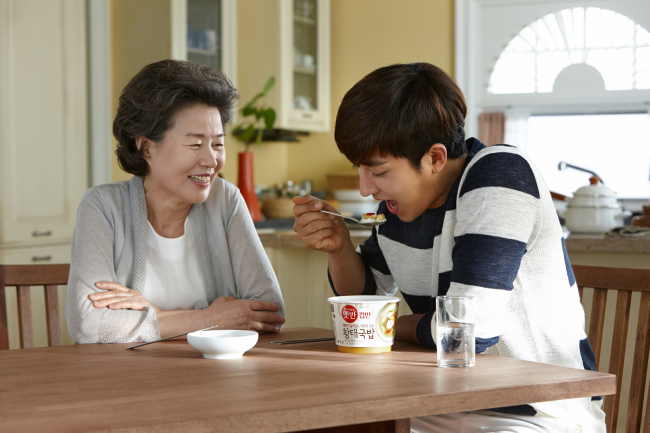'Home’ will drive 2016 consumer trends: survey
Easy-to-cook homemade food, upgraded home meal replacements, capsule coffee to fuel growth next year
By 손지영Published : Dec. 17, 2015 - 17:40
Pressed for time and short on money amid an economic downturn, South Koreans today tend to seek sanctuary from the hustle and bustle of daily life at home -- a place of comfort where one can unwind and rest freely.
As Koreans increasingly feel busy, anxious and short of money to spare, many are likely to spend more time at home next year, according to the 2016 Korea Trend Report by market researcher Macromill Embrain.
“Home” is thus a key concept that will shape and drive consumption patterns next year, giving way to the emergence of new consumer goods tailored for the home -- an alternative space that is rising in importance, according to the report.
As Koreans increasingly feel busy, anxious and short of money to spare, many are likely to spend more time at home next year, according to the 2016 Korea Trend Report by market researcher Macromill Embrain.
“Home” is thus a key concept that will shape and drive consumption patterns next year, giving way to the emergence of new consumer goods tailored for the home -- an alternative space that is rising in importance, according to the report.

Of the 2,000 people surveyed by Macromill, around 75.1 percent said they “lacked time” while 77.1 percent reported “anxiety in daily life.” The response rates were found to be around 3-4 percentage points higher than the rates seen last year.
About 69.2 percent said they felt “anxious about their economic standing” while 53.4 percent answered that they “faced more economic hardships in 2015 compared to last year,” according to the survey.
Meanwhile, 81.9 percent reported “feeling most relaxed at home” while 56.9 percent said they are “spending more time at home amid growing social anxieties” and 75.2 percent responded “they can do many things at home without stepping out.”
Taken together, Macromill Embrain predicts new in-house goods, services and activities will rise in popularity as people stay at home longer and seek to improve their living spaces and home lifestyles.
“As today’s Koreans increasingly feel short of time, financially strained and emotionally void, they are expected to continuously do more things at home, propelling forward industries like the home food and home interior segments,” said Song Yeu-ddeum, one of the coauthors of the report at Macromill Embrain.
Marking a growing trend set to continue into 2016 is “jipbap” products -- premium home-cooked meals that go beyond the shortcomings of instant foods, which often compromise on health and freshness for the sake of convenience.
Longer time spent at home coupled with the desire for healthy meals with a touch of home has led food developers to introduce products that enable homemade cooking -- all without the hassles of cooking from scratch.

Mindful that one of the most difficult and cumbersome parts of Korean cooking is preparing the numerous ingredients and striking that right mixing ratio, local food producers have newly launched readymade sauces that enable easy cooking with homemade tastes.
Market leader CJ Cheil Jedang currently makes sauces for jjimdak, a spicy steamed chicken dish; bulgogi, a marinated beef dish; and tteokbokki, or spicy rice cakes; among others.
“If home cooking involves having to buy and prepare all sorts of ingredients from scratch, eating out would become a more appealing option for even those who want a hot, home-cooked meal,” a CJ Cheil Jedang spokesperson told The Korea Herald, explaining the function of its readymade sauces.
“Riding the ‘jipbap’ craze that has hit the nation, sales of our readymade sauces have been continuously rising,” she said, adding that public preference for “jipbap” is set to continue into 2016.
Alongside CJ, Daesang Chungjungone and E-Mart’s packaged food brand Peacock are geared to continue improving expanding their premade sauce lineups to cater to wider tastes.
For those seeking even more simplicity in dining at home are upgraded home meal replacement, or HMR, foods -- packaged food ready for instant consumption -- that have been improved for fresher tastes, quality and convenience.
They include CJ’s “cupban” -- which combines its flagship “hetban,” microwaveable rice, with a cup of soup that can be easily prepared with hot water -- as well as Ottogi’s diversified lineup of rice toppings and readymade soups like samgyetang, boiled whole chicken stew, made by brands like Ourhome and Peacock, among others.
Industry watchers expect packaged-food producers to roll out more innovative products in terms of taste and convenient packaging in the years to come.
Meanwhile in the beverages front, coffee and equipment designed for consumption at home are forming a new business segment set to continue growth in Korea, home to one of the most avid coffee drinkers in the world.

Some 89.5 percent of Koreans surveyed by Macromill Embrain said they wanted to “build up a home environment where they can sit and enjoy a cup of coffee,” signaling a growing preference for quality coffee brewed at home.
The advancement of homebrew coffee machines, the heightened variety of coffee beans available and expensive coffee prices at cafes are giving way to the expansion of the so-called “home cafe” culture here.
Led by the Nescafe Dolce Gusto, sales of capsule coffee machines in the domestic market grew by 73.4 percent in the first quarter of 2015, according to GFK Research.
Nestle Korea, which owns Nescafe, said it foresees its capsule coffee sales to grow by 14 times by 2020, citing immense potential for the segment’s growth in the country. The brand’s machine installation rate stood at 1.3 percent as of 2014, compared to a rate of more than 25 percent seen in countries like France, Germany and Spain.
Eyeing a growing pool of home cafe owners, franchise cafes, including Tom N Toms and Caffe Bene, have jumped onto the home cafe trend by launching a number of home cafe accessories including Dutch coffeemakers, coffee grinders and home-use coffee machines.
Certain coffee brands are also running classes teaching the public how to discover and brew different coffee varieties at home according to preference, seeking to increase their brand image.
By Sohn Ji-young (jys@heraldcorp.com)







![[Weekender] How DDP emerged as an icon of Seoul](http://res.heraldm.com/phpwas/restmb_idxmake.php?idx=644&simg=/content/image/2024/04/25/20240425050915_0.jpg&u=)



![[KH Explains] No more 'Michael' at Kakao Games](http://res.heraldm.com/phpwas/restmb_idxmake.php?idx=644&simg=/content/image/2024/04/28/20240428050183_0.jpg&u=20240428180321)






![[Herald Interview] Mistakes turn into blessings in street performance, director says](http://res.heraldm.com/phpwas/restmb_idxmake.php?idx=652&simg=/content/image/2024/04/28/20240428050150_0.jpg&u=20240428174656)
